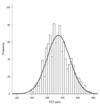1. Pesando PM, Ghiringhello MP, Tagliavacche P. Posterior chamber collamer phakic intraocular lens for myopia and hyperopia. J Refract Surg. 1999. 15:415–423.
2. Yaylali V, Kaufman SC, Thompson HW. Corneal thickness measurements with the Orbscan Topography System and ultrasonic pachymetry. J Cataract Refract Surg. 1997. 23:1345–1350.
3. Shimmura S, Yang HY, Bissen-Miyajima H, et al. Posterior corneal protrusion after PRK. Cornea. 1997. 16:686–688.
4. Probst LE, Machat JJ. Mathematics of laser in situ keratomileusis for high myopia. J Cataract Refract Surg. 1998. 24:190–195.
5. Ehlers N, Bramsen T, Sperling S. Applanation tonometry and central corneal thickness. Acta Ophthalmol (Copenh). 1975. 53:34–43.
6. Doughty MJ, Zaman ML. Human corneal thickness and its impact on intraocular pressure measures: a review and meta-analysis approach. Surv Ophthalmol. 2000. 44:367–408.
7. Whitacre MM, Stein RA, Hassanein K. The effect of corneal thickness on applanation tonometry. Am J Ophthalmol. 1993. 115:592–596.
8. Wolfs RC, Klaver CC, Vingerling JR, et al. Distribution of central corneal thickness and its association with intraocular pressure: the Rotterdam Study. Am J Ophthalmol. 1997. 123:767–772.
9. Brandt JD, Beiser JA, Kass MA, Gordon MO. Central corneal thickness in the Ocular Hypertension Treatment Study (OHTS). Ophthalmology. 2001. 108:1779–1788.
10. Osuobeni EP. Ocular components values and their intercorrelations in Saudi Arabians. Ophthalmic Physiol Opt. 1999. 19:489–497.
11. Aghaian E, Choe JE, Lin S, Stamper RL. Central corneal thickness of Caucasians, Chinese, Hispanics, Filipinos, African Americans, and Japanese in a glaucoma clinic. Ophthalmology. 2004. 111:2211–2219.
12. Shimmyo M, Orloff PN. Corneal thickness and axial length. Am J Ophthalmol. 2005. 139:553–554.
13. Kunert KS, Bhartiya P, Tandon R, et al. Central corneal thickness in Indian patients undergoing LASIK for myopia. J Refract Surg. 2003. 19:378–379.
14. Von Bahr G. Corneal thickness; its measurement and changes. Am J Ophthalmol. 1956. 42:251–266.
15. Alsbirk PH. Corneal thickness. I. Age variation, sex difference and oculometric correlations. Acta Ophthalmol (Copenh). 1978. 56:95–104.
16. Chang SW, Tsai IL, Hu FR, et al. The cornea in young myopic adults. Br J Ophthalmol. 2001. 85:916–920.
17. Srivannaboon S. Relationship between corneal thickness and level of myopia. J Med Assoc Thai. 2002. 85:162–166.
18. Touzeau O, Allouch C, Borderie V, et al. Correlation between refraction and ocular biometry. J Fr Ophtalmol. 2003. 26:355–363.
19. Martola EL, Baum JL. Central and peripheral corneal thickness: a clinical study. Arch Ophthalmol. 1968. 79:28–30.
20. Hansen FK. A clinical study of the normal human central corneal thickness. Acta Ophthalmol (Copenh). 1971. 49:82–89.
21. Cho P, Lam C. Factors affecting the central corneal thickness of Hong Kong-Chinese. Curr Eye Res. 1999. 18:368–374.
22. Price FW Jr, Koller DL, Price MO. Central corneal pachymetry in patients undergoing laser in situ keratomileusis. Ophthalmology. 1999. 106:2216–2220.
23. Liu Z, Pflugfelder SC. The effects of long-term contact lens wear on corneal thickness, curvature, and surface regularity. Ophthalmology. 2000. 107:105–111.
24. Pedersen L, Hjortdal J, Ehlers N. Central corneal thickness in high myopia. Acta Ophthalmol Scand. 2005. 83:539–542.
25. Fam HB, How AC, Baskaran M, et al. Central corneal thickness and its relationship to myopia in Chinese adults. Br J Ophthalmol. 2006. 90:1451–1453.
26. Lim SJ, Choi O. Interrelationship of the refractory error and the ocular axial length and the anterior chamber depth in the myopic eyes. J Korean Ophthalmol Soc. 1986. 27:371–376.
27. Rao SN, Raviv T, Majmudar PA, Epstein RJ. Role of Orbscan II in screening keratoconus suspects before refractive corneal surgery. Ophthalmology. 2002. 109:1642–1646.
28. Drexler W, Findl O, Menapace R, et al. Partial coherence interferometry: a novel approach to biometry in cataract surgery. Am J Ophthalmol. 1998. 126:524–534.
29. Goss DA, Van Veen HG, Rainey BB, Feng B. Ocular components measured by keratometry, phakometry, and ultrasonography in emmetropic and myopic optometry students. Optom Vis Sci. 1997. 74:489–495.
30. Foster PJ, Baasanhu J, Alsbirk PH, et al. Central corneal thickness and intraocular pressure in a Mongolian population. Ophthalmology. 1998. 105:969–973.








 PDF
PDF ePub
ePub Citation
Citation Print
Print





 XML Download
XML Download